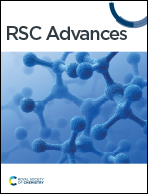Curcumin-PLGA based nanocapsule for the fluorescence spectroscopic detection of dopamine
Abstract
The main purpose of this paper is to design curcumin loaded PLGA nanocapsules for the selective detection of dopamine using fluorescence spectroscopy. In the present work curcumin loaded PLGA nanocapsules were synthesized using a solid-in-oil-in water (s/o/w) emulsion technique. The prepared nanocapsules were coated with a poly(diallyldimethylammonium)chloride (PDDA) polymer to increase the entrapment of curcumin into the core of PLGA polymer. PLGA-Cur-PDDA nanocapsules were characterized using different microscopic and spectroscopic techniques. Unlike free curcumin, the formed CUR-PLGA-PDDA NCs were established as nanoprobes for the selective detection of dopamine molecules. The selectivity and specificity of nanocapsules toward dopamine was achieved by measuring the fluorescence emission spectra of the NCs in the presence of other interference molecules such as tryptophan, melamine, adenine, etc. It was noticed that increasing the concentration of the different molecules had no significant change in the fluorescence signal of the nanocapsules. These results confirm the strong quenching between dopamine and curcumin in the nanocapsules. Hence, this fluorescence emission technique was found to be selective, easy and fast with low cost for the determination of dopamine in a concentration range up to 5 mM with a detection limit equal to 22 nM.



 Please wait while we load your content...
Please wait while we load your content...